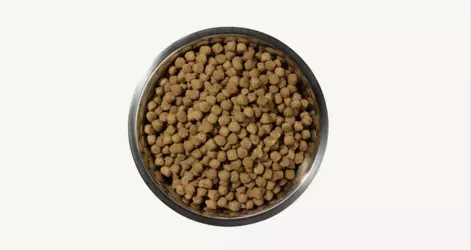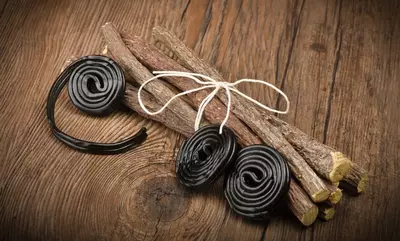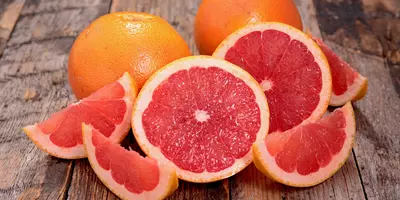Is Dry Food Good for Dogs?
- 09 Dec 2019
- 6m read

If we had to pick between delicious, freshly prepared meals or crunchy, dehydrated, brown pellets, there'd be no contest. We'd go fresh every time. We're not astronauts, after all. And we think the furrier members of our family would make the same choice. Because they're not astronauts, either.
How is Dry Dog Food Made?
Dry dog food, often referred to as kibble, is made through a process called extrusion, which basically takes raw ingredients and cooks them at extremely high temperatures.
The product is then cut into shapes, dried out with hot air, cooled and coated in oils to boost flavour.
And… breathe. That’s a lot of effort to produce some unappealing brown balls. Cooking at such high temperatures is likely to strip a large portion of the beneficial nutrients away too, which is a big thumbs down from us.
Advantages of Dry Dog Food
Cost
Due to the bulk-manufacturing methods and often, cheap ingredients, it is fairly easy for dry dog food to be sold at a lower price point. Many dog owners use dry food to mix feed alongside other types of dog food, such as fresh, to bring overall costs down.
Convenience
You can pick dry dog food up at pretty much any supermarket, usually next to the bin bags and bleach… sadly. It is this convenience that makes it an easy choice when it comes to filling your pooch’s tum.
Disadvantages of Dry Dog Food
Heavy carbohydrate content
Dry dog biscuits can be full of carbohydrates as these help the biscuits stick together and add bulk. We think it's better to fill that space with the good stuff. Just meat, veg and some vitamins and minerals. Carb-heavy recipes with traditional cereals like wheat and corn, can trigger intolerances and reactions – so feeding your pooch Butternut Box meals may help to avoid itchy skin and tummy upsets.
Highly processed
As mentioned earlier, dry dog food goes through a multi-step process before it reaches the final product, which looks very different to the ingredients that it started with.
It seems unnecessary to take fresh ingredients and process them for the sake of a longer shelf life. It's not like our pups are preparing for an a-paw-calypse.
My Dog Has Stopped Eating Dry Food, Why?
Disinterest in their food can simply be a result of boredom, we certainly wouldn’t want to eat the same meal everyday and often dogs can feel the same way. It could be your dog's way of signalling to you that they want to try something new.
Every parent of a picky pup knows the scenario. Your pooch takes one sniff of the contents of their bowl, then turns to give you The Look. Translated to human language this means, do you really expect me to eat this?
When your dog refuses their food, it makes you worry. It can be tempting to give them extra treats or scraps of your own food. Of course, this makes them even fussier, because now they know how to get something tastier than dry dog food kibble. A treat-heavy diet can play havoc with your dog's digestive system, leaving you to don the rubber gloves and deal with the accidental consequences.
While it's hard to resist those puppy-dog eyes, there is another way. Feed them a tasty, moist meal containing everything they need to thrive. Butternut Box meals can be served cold or warmed in the microwave. The appetising scent is sure to get that tail set on hyper-wag.
Is Dry Food Good for Cleaning Dog’s Teeth?
One of the most common myths in the dog food industry is that dry dog food helps to clean dogs teeth, due to the chewing involved whilst they’re eating. It has become a major selling point for many dry dog food brands, however it is not as effective as you might have been convinced of.
Other Types of Dog Food
Wet / tinned
Traditionally, wet food, usually in tins, has been the go-to way to feed our dogs. Wet food is made by combining all of the raw ingredients, grinding them down and cooking at a temperature that activates the starches and thickens the mixture, giving it the jelly-like appearance. It is then added to cans, sealed and sterilised.
Along the way all sorts can be added to it, including preservatives to lengthen its shelf life and nutritionally-incomplete fillers to ‘bulk’ the product out.
Raw
Raw dog food is, as you would expect, raw meat (bones included) combined with things like raw eggs, fruit, vegetables and dairy products. Known as the BARF (biologically approved raw food diet), it is the closest your pooch will get to the diet of their canine ancestors. For this reason, there are many advocates for the diet.
However, the drawback of a raw diet is that there is a huge risk of bacterial contamination. When handling and serving raw food you must exercise extreme caution to prevent the introduction of this bacteria into your home, especially in households with small children. It is also generally recommended that you avoid feeding raw food to pooches with sensitive stomachs, including puppies and dogs with pancreatitis.
Fresh (the best alternative)
Step aside, brown balls – there's a new dog food in town. While dry food has been filling pets' tummies since the 1950s, freshly cooked is quickly becoming the most popular dog food category. The idea behind fresh is that it is produced in a similar way to how you would cook at home, without actually having to cook it at home, thanks to fresh pet food suppliers, such as us.
Fresh food preparation involves taking quality, raw ingredients and gently cooking them to kill off any unwanted bacteria but retain vital nutrients. There's no heavy processing and no artificial ingredients or pointless fillers are added. The food can be preserved for longer by being placed in the freezer.
Butternut Box vs Dry Food
We know that feeding dry food can be handy. Just grabbing the bag and tipping it into the bowl is quick and easy, but there is a risk that your pooch might not be getting the right amount of food for their individual needs. Keeping track can be tricky.
To make sure your pup gets the right calories to match their age, size and lifestyle, Butternut Box meals are served in handy, perfectly-portioned pouches. We'll ask a few simple questions about your Butternutter when you sign up, then we'll crunch the numbers, put together a customised meal plan and deliver it to your door. You might want to prepare yourself for new-found popularity.
With Butternut Box, your dog can have delicious meals that are as good as you'd cook at home. While we know that our meals have the drool factor (our four-legged testers tell us via the medium of enthusiastic tail wags), we're proud that our recipes are full of goodness, too.
A healthy, nutritious diet helps to keep pooches healthy. It maintains a healthy skin and coat, after all, no one likes dogdruff (yes we did make that word up, and yes, we're using it). There are good reasons why Butternut Box delivers these benefits. It's all about what we put in (and what we don't).
Fun fact, we taste-test our dog meals ourselves, as well as getting an opinion from our furry friends. You might be pulling a face in response to that idea, but it's OK – we can do this because we only use high-quality, human-quality ingredients. No meat meals, no bone meals and none of the other mysterious ingredients you might find if you scanned the back of a pack of dry food.

.webp)


